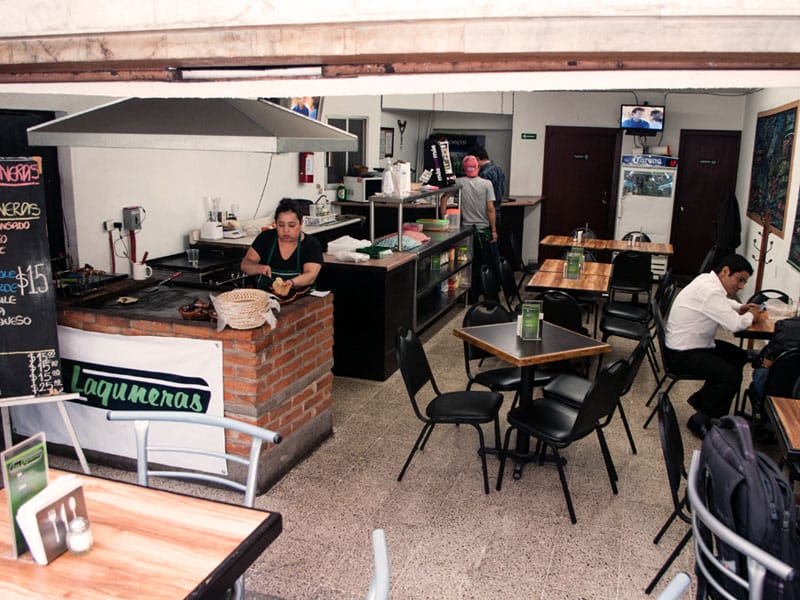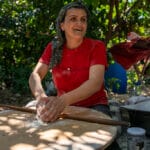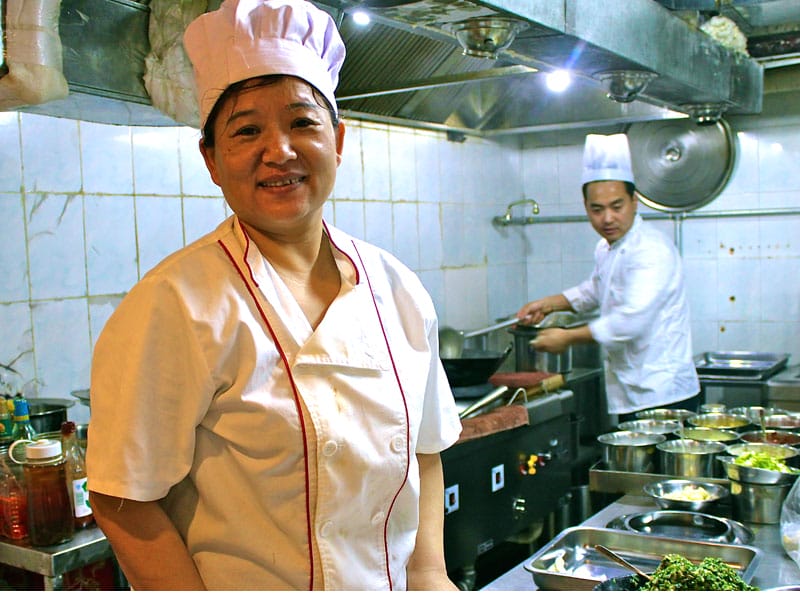Update: This spot is sadly no longer open.
Come Sunday, we often find ourselves strolling through leafy Parque Sullivan, which hosts Mexico City’s largest outdoor art market. The art here ranges from modern to whimsical, abstract to landscapes, created by artists who no doubt have dreams of being the next Diego Rivera or Frida Kahlo. When we get hungry, we usually head over to nearby Sullivan Market to get a taste of the culinary artistry of the food vendors working there. But on a recent Sunday, we decided to follow the advice of friends and try something new in the neighborhood: the gorditas over at Las Laguneras.
Like several other Mexican dishes, such as tamales, tacos and quesadillas, gorditas are eaten around the country, with different variations seen from region to region. Regardless of the region, however, these small patties are always round in shape (unlike oval-shaped tlacoyos or huaraches) and stuffed to the gills with assorted fillings – hence their name, which translates to “fat little girl” and is a friendly Mexican nickname and term of endearment.
Las Laguneras owner Armando Cárdenas, who hails from the city of Torreón in the northern Mexican state of Coahuila, arrived in Mexico City less than a year ago with the goal of opening a restaurant. His idea was to bring Torreón-style gorditas to Defeños (as people from the capital are known), as well as to serve the population of Torreón transplants in the city. The location directly across from Sullivan Park at the edge of the Cuauhtémoc neighborhood seemed perfect, and with gordita recipes in tow, Cárdenas opened Las Laguneras within just a few months of his arrival.

In keeping with Cárdenas’s singular mission, Las Laguneras offers one food item – gorditas – in numerous variations. In Mexico City, gorditas are typically made with corn masa, stuffed with chicharrón prensado (pressed pork scraps left over from carnitas), deep-fried and then topped with cheese, lettuce and salsa. Torreón-style gorditas, on the other hand, can be made with either corn masa or wheat flour, are grilled rather than fried and are served without toppings. But this lack of toppings is made up for by the many different ingredients used as fillings. At Las Laguneras, the dozen or so fillings range in spiciness, on a scale represented by up to two chili symbols underneath each menu item. (Mexican food can be very spicy or not at all depending on individual recipes and preferences, so it can be nice to have an indication of the spice quotient.)
Of the spicy options, we tried the guisado verde, a pork and potato version made with chili-infused tomatillo salsa, and the asado, a very popular Torreón filling that was also made with pork chunks, but in a red salsa made with several dried peppers (Armando remained mum as to the specific types of peppers). Being grilled rather than fried, the gorditas were less greasy than what we’re used to eating in Mexico City but otherwise contained all the deliciousness of the fried version, and we gladly ordered a second round. We then moved on to several milder flavors: the picadillo, a beef, potato and carrot concoction in a tomato base; rajas con queso, or poblano peppers smothered in Oaxacan cheese; and frijoles, which, as the name implies, is packed with refried beans and cheese. We had no room left in our stomachs to try the other variations, including chicken and mole; chicharrón, or pork skin; queso, or plain Oaxacan cheese; and huevo con chili, an egg and chili pepper mix. All of the fillings are prepared daily and then kept warm in handmade clay pots that line one end of the grill.
The décor at Las Laguneras is somewhat Spartan, with plain white walls and no-frills furniture. The highlight for us was the covered sidewalk patio, which offered a nice view of the bustling park and its giant palms and blooming jacarandas. Indeed, with its simple style and menu, Las Laguneras seeks to impress not so much with aesthetics, but by doing one thing and doing it well. Although not open very long, its reputation is already spreading. For us, it is one of the best stops we’ve found yet for gorditas, making Sundays in Parque Sullivan all the more enticing.
Published on April 17, 2013
Related stories
December 7, 2015
IstanbulOn the western coast of Turkey, the town of Alaçatı sways to the light of a thousand glowing cafés. What was once a typically beautiful and sleepy Turkish fishing village has transformed into a hub for glitzy nightlife. People swarm the seaside walkways to see and be seen, arriving in metallic SUVs and humming Italian…
September 26, 2023
Istanbul | By Gonca Tokyol
IstanbulIn a tangerine orchard in Mızraklı, one of the many mountainous villages in Turkey's southern Hatay province, Yeliz Yoğun sat next to a burn pit rolling yufka – Turkish flatbreads – for her mother, Sabah, to bake. On this summer morning, the temperature was already high while standing under the trees, away from the fire,…
June 12, 2013
ShanghaiIt’s not every day that you find a former national volleyball champ in the kitchen, but that’s just the case with Lu Dajie (aka “Big Sister” Lu) and her eponymous restaurants. After a successful career with the Chinese military’s volleyball team, followed by years working in restaurants for others, she left her hometown of Jianyang…


















































































